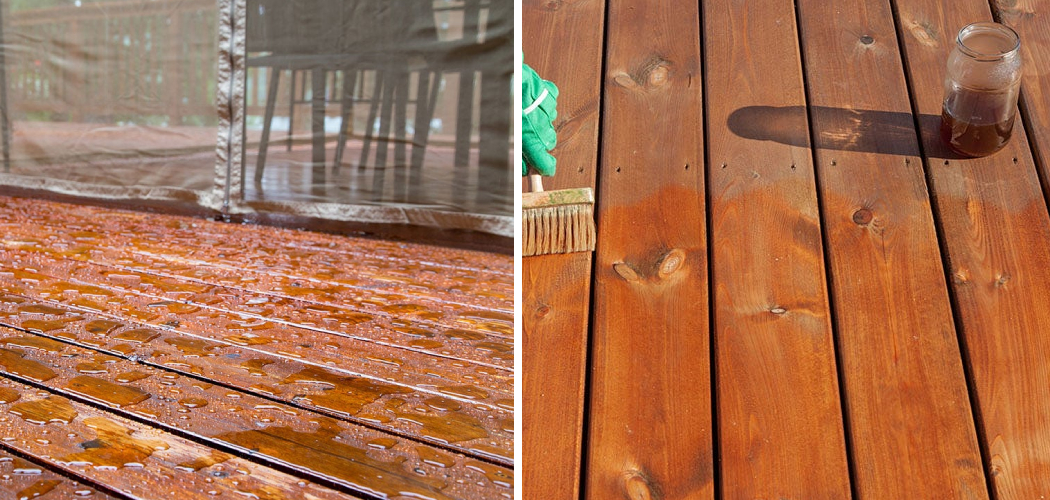When you think of outdoor entertaining, a wood deck often comes to mind. It adds value to your home and provides an inviting atmosphere for time spent with family or friends. But those same unprotected surfaces can be ruined in an instant by rain, hail, heavy winds, and other weather conditions—which is why it’s so important to waterproof your wood deck before the rainy season starts.
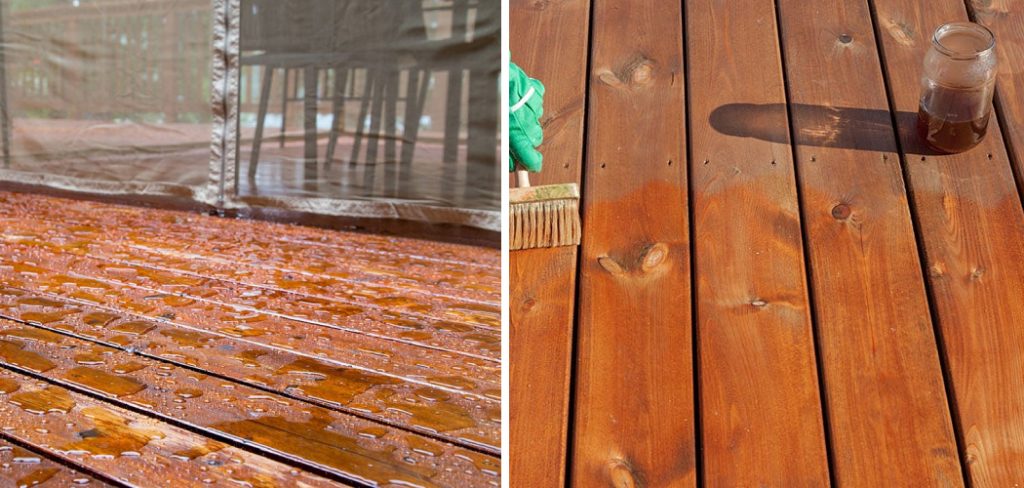
In this blog post, we’ll cover all the basics of how to waterproof wood deck. From choosing the right products for the job and prepping and cleaning your work surface correctly through applying sealant or stain and maintaining your piece over time – you’ll have everything you need to keep your beautiful wooden deck safe from water damage!
The Importance of Waterproofing a Wood Deck
Wood decks are a beautiful addition to any home. They provide the perfect outdoor space for entertaining, relaxing and enjoying the great outdoors. However, exposed wood can be vulnerable to damage from moisture or water. Without proper waterproofing, your deck will not last long and may become unsafe to use due to rotting wood or slippery surfaces caused by mold or mildew growth.
Waterproofing a wood deck is essential to protect it against moisture damage that can lead to costly repairs or replacement. Waterproofing helps prevent splintering of the wood as well as warping and cracking under extreme temperatures and weather conditions. This also protects against dangerous mildew and mold growth which can present health risks such as respiratory illnesses, asthma and allergies. In addition, waterproofing your deck will help protect it from rot and decay which can cause structural weakness and endanger anyone who is on the deck.
Furthermore, waterproofing a wood deck helps extend its lifespan. Regular sealing and maintenance of the deck will greatly reduce the possibility of costly repairs down the road. Without regular care, you may need to replace sections or even have to replace the entire deck due to significant damage caused by moisture. Properly maintaining your wood deck with sealants and other treatments can save you money in the long run.
Benefits of a Waterproofed Deck
Waterproofing a wooden deck has numerous advantages that make it well worth the effort and cost. Perhaps the most significant benefit of waterproofing your deck is that it helps to preserve its appearance and longevity. By preventing water damage, you can ensure that your deck will look great for years to come. In addition, waterproofing a deck adds an extra layer of protection and safety against slips or falls due to wet surfaces.
This makes your outdoor space much more enjoyable, especially in rainy climates. Finally, waterproofing your deck can offer increased resistance from pests like termites which can cause considerable damage if left unchecked. With all these benefits combined, it’s clear why so many homeowners choose to waterproof their decks!
A properly waterproofed wood deck can be a beautiful and inviting outdoor space, perfect for entertaining guests or simply enjoying the outdoors. With the right materials and application techniques, you can ensure that your deck will look great and last for years to come!
Inspecting for Any Damage or Decay
Before attempting to waterproof a wood deck, it is important to inspect the surface for any signs of damage or decay. Inspecting the wood for signs of rot, mold, or water-damaged areas can save time and money in the long run by ensuring that all necessary steps are taken to ensure optimal protection for the deck boards.
If there is evidence of rot or decay, it should be treated before proceeding with the waterproofing process. Additionally, any broken or cracked boards should also be replaced before applying the sealer. It is important to note that sealing a wooden deck does not correct any existing issues and will only protect against future problems if done properly. Therefore, inspecting and addressing any underlying issues prior to waterproofing is essential for successful results.
Once the deck has been inspected and any necessary repairs completed, it is time to begin preparing for waterproofing. Before applying the sealer, make sure that the wood is completely dry and free of dirt or debris. Cleaning the wood with a pressure washer can help remove any dirt or grime that may be stuck on due to mildew growth or other environmental elements.
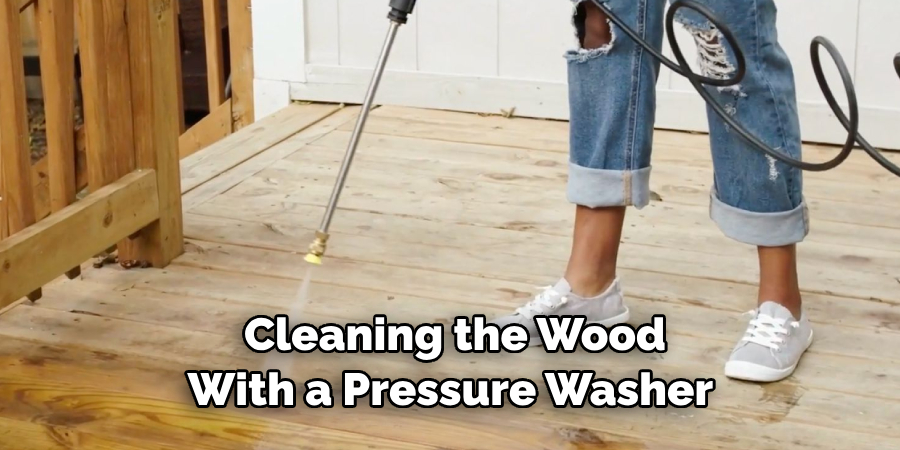
If using a pressure washer, use caution not to damage the wood with too much force and take care to ensure all areas are adequately cleaned before proceeding. Additionally, sanding may also be necessary in order to create a smooth surface texture prior to sealing. After preparation is complete, it’s time to apply the sealer!
10 Ways How to Waterproof Wood Deck
1. Clean and Prepare the Deck:
Start by thoroughly cleaning the wood deck to remove dirt, debris, and any existing coatings. Use a deck cleaner or a solution of mild detergent and water, along with a stiff brush or power washer, to scrub the surface. Allow the deck to dry completely before proceeding. While the deck is drying, replace any boards or fasteners that are damaged.
2. Inspect and Repair the Wood:
Carefully inspect the deck for any signs of damage, such as loose boards, cracks, or rotten sections. Replace or repair any damaged wood to ensure a solid and stable deck structure. Addressing these issues before waterproofing will help prolong the life of your deck. To ensure that the deck is ready for waterproofing, use a pressure washer to clean off any dirt or grime and remove existing sealant.
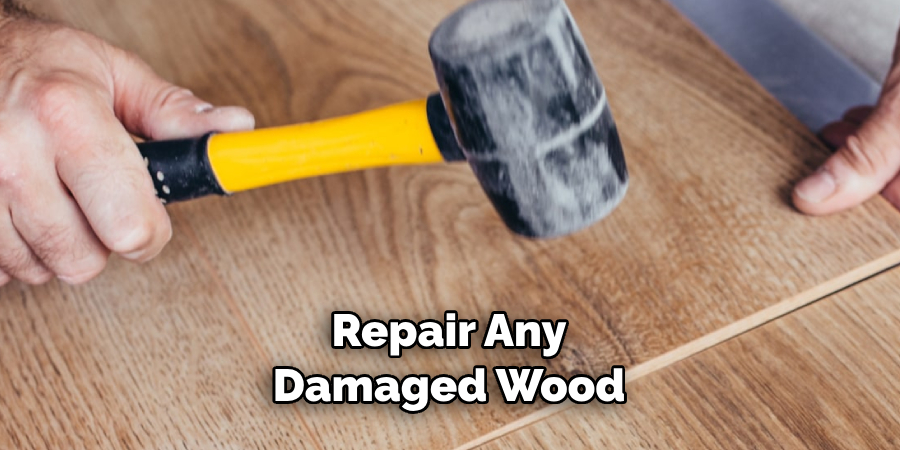
3. Sand the Surface:
Smooth out rough spots and any splintered areas on the wood deck by sanding the surface. Use a coarse-grit sandpaper initially, followed by a finer grit for a smooth finish. Sanding helps to create a clean and even surface for the waterproofing application. Make sure to wipe the surface with a damp cloth, and then allow the wood deck to completely dry before applying waterproofing.
4. Test for Water Absorption:
Before applying any waterproofing product, conduct a water absorption test on the deck. Sprinkle water onto various sections of the wood and observe how quickly it is absorbed. If the water beads up or does not penetrate the wood, the deck may not require waterproofing. However, if the water is absorbed, proceed with the waterproofing process.
5. Choose a Suitable Waterproofing Product:
There are several types of deck waterproofing products available, including sealers, stains, and paints. Select a product specifically designed for wood decks, considering factors such as durability, UV protection, and resistance to mold and mildew. Read and follow the manufacturer’s instructions for application guidelines.
6. Apply a Waterproofing Sealer:
Start by applying a waterproofing sealer to the wood deck. Use a roller, brush, or sprayer to evenly coat the entire surface, working in small sections. Pay extra attention to the areas prone to moisture exposure, such as joints, seams, and around railings. Allow the sealer to penetrate and dry according to the manufacturer’s recommendations. Reapply a second coat to ensure the maximum waterproofing effect. Wait for at least 24 hours before walking on the deck or applying another finish, such as a stain.
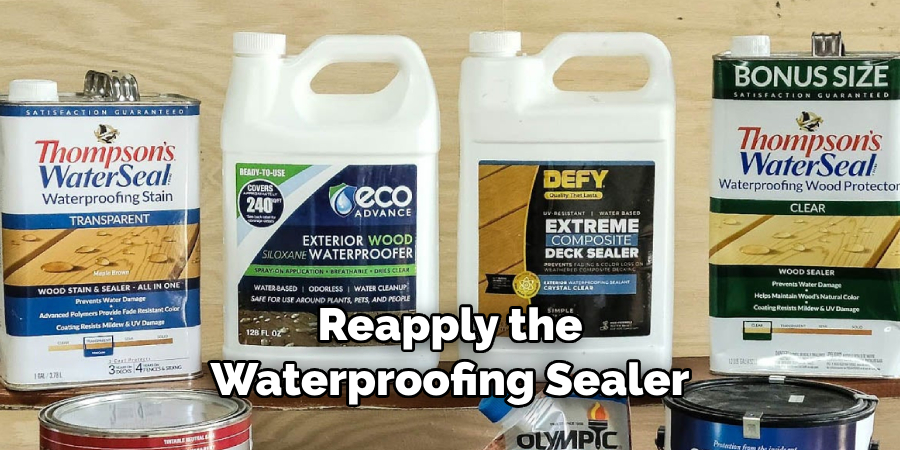
7. Consider a Deck Stain or Paint:
If desired, enhance the appearance of your wood deck by applying a deck stain or paint after the waterproofing sealer has dried. Deck stains provide a natural look and allow the wood grain to show through, while paints offer a wide range of colors and provide a more opaque finish. Ensure the stain or paint is formulated for exterior wood and provides waterproofing properties.
8. Apply Multiple Coats:
To achieve maximum waterproofing protection, apply multiple coats of the chosen product. Follow the manufacturer’s instructions regarding the recommended number of coats and the drying time between applications. Additional coats help build up a stronger barrier against moisture penetration and prolong the lifespan of your deck. Furthermore, it is important to ensure that each layer of sealant is completely dry before adding a new coat. If necessary, lightly sand between coats for a smooth finish.
9. Maintain the Waterproofing:
Regular maintenance is essential to preserve the waterproofing of your wood deck. Inspect the deck annually for signs of wear, damage, or fading. Depending on the product used, you may need to reapply the waterproofing sealer, stain, or paint every few years. Promptly address any issues to prevent water damage and ensure the deck remains protected.
If you notice any scratches or chips, repair them with wood filler and then apply a new coat of sealer. Finally, sweep the deck regularly to remove dirt and debris, which can break down the waterproofing sealer and cause it to chip.
10. Practice Preventive Measures:
Alongside waterproofing, implement preventive measures to further protect your wood deck. Place doormats at entrances to minimize the tracking of dirt and moisture onto the deck. Use furniture pads or coasters to prevent scratches and water damage caused by direct contact with objects. Promptly clean up spills and remove leaves or debris that may accumulate on the deck’s surface.
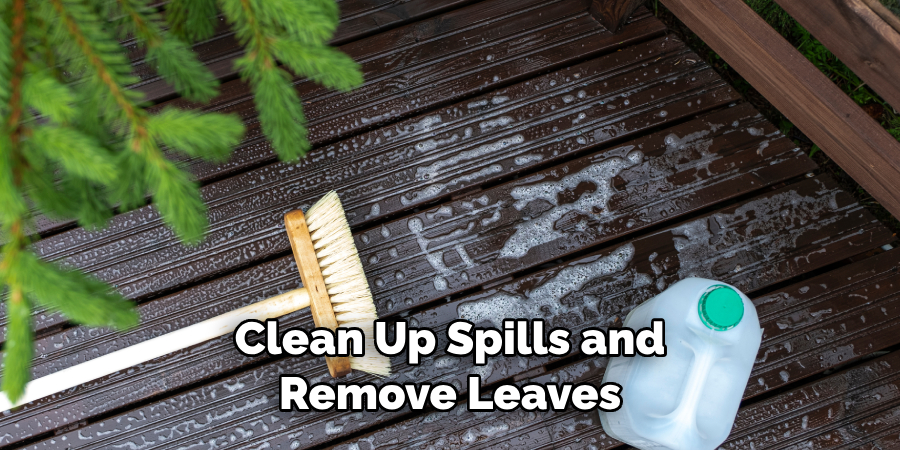
Conclusion
After finishing this blog post, you are now equipped with all the tips and tricks necessary to waterproof your wood deck. With proper maintenance and regular waterproofing treatments, your wood deck will be able to withstand all sorts of weather conditions. We recommend starting with a deep clean of your deck before applying any waterproof coatings, followed by thorough dry time in between layers of coating for the best seal.
Finally, once the job is complete, it is important to remember to reseal your deck every one to two years as part of an ongoing maintenance plan. Not only will this extend the life of your wood deck, but it may also help prevent more expensive repairs down the road. By using these steps as an effective guide on how to waterproof wood decks, you can have confidence knowing that your outdoor patio space is protected and ready for use rain or shine!

